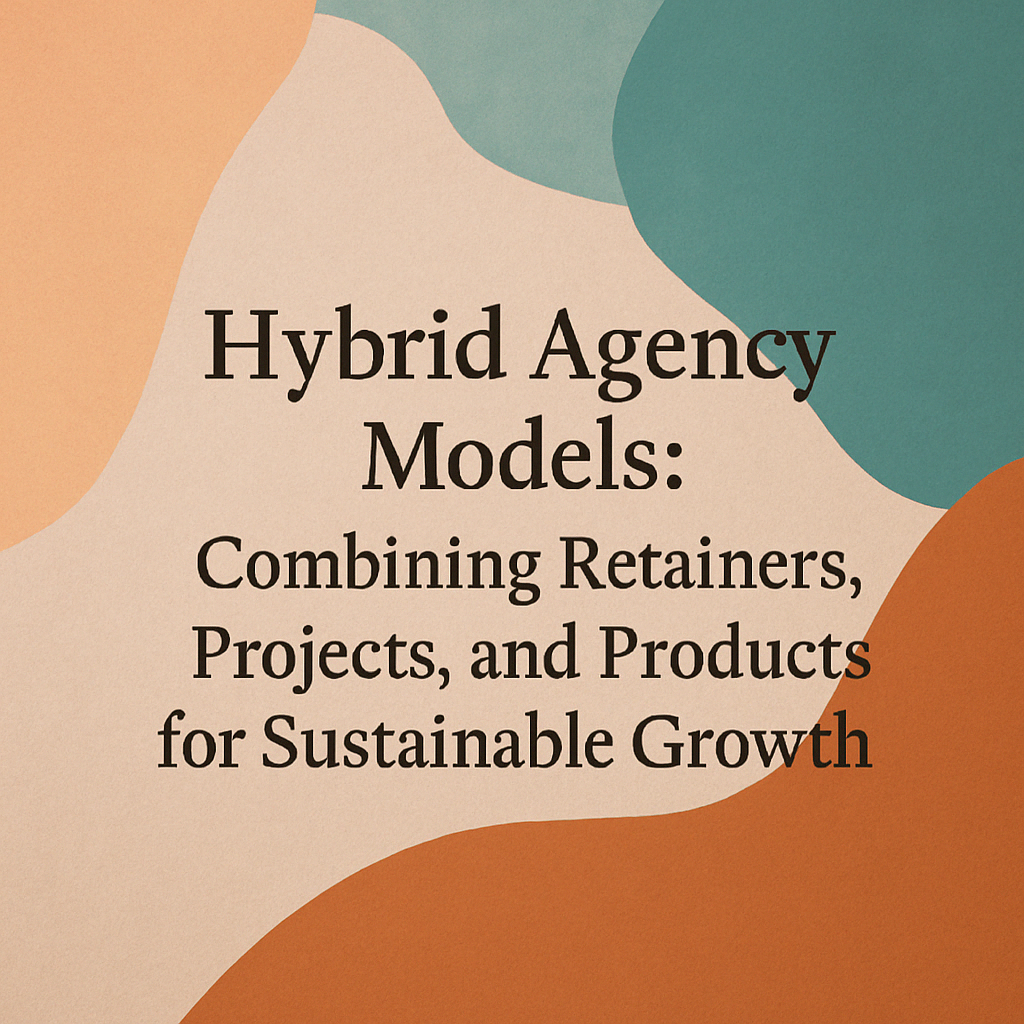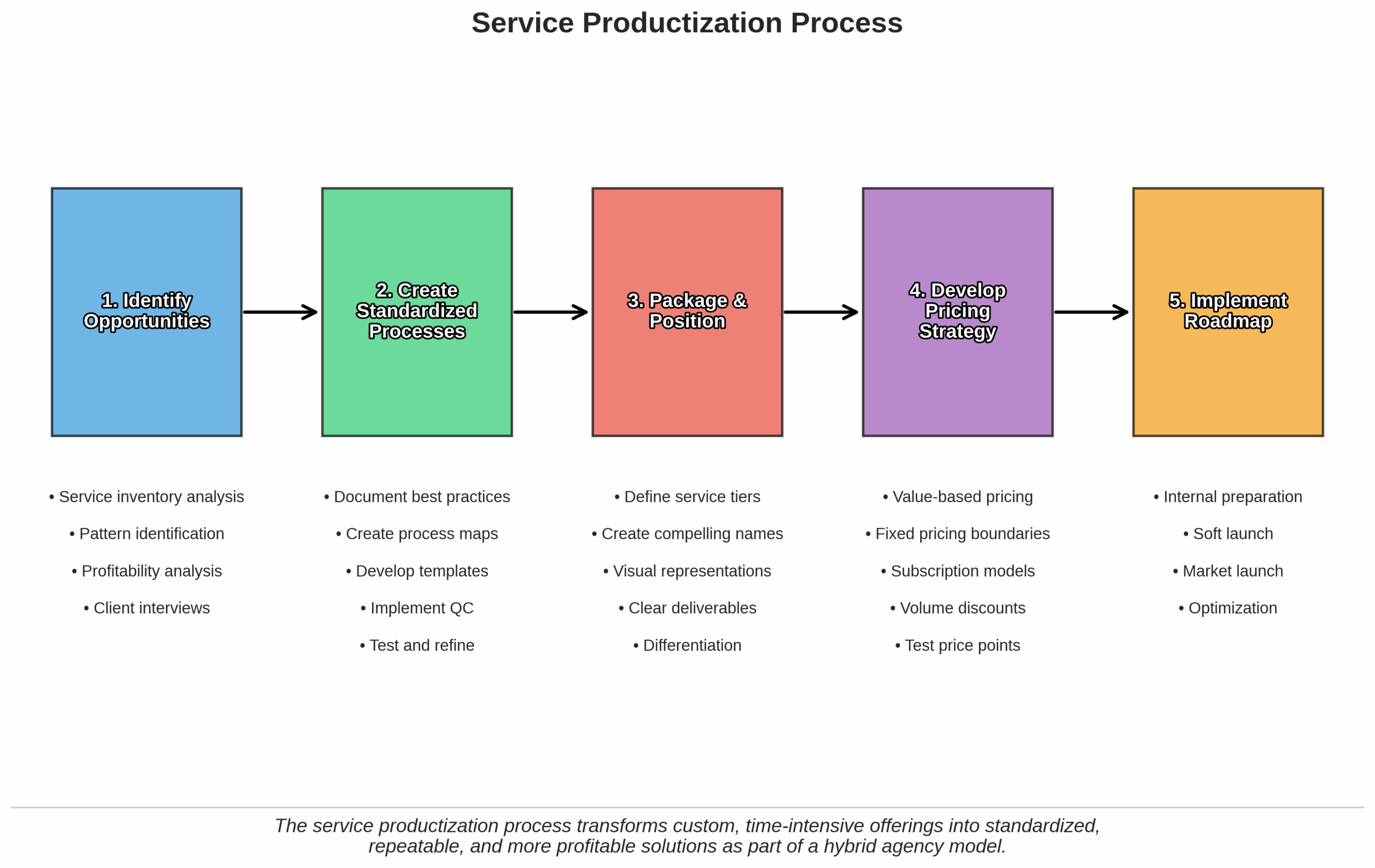The future agency doesn’t choose between retainers, projects, or products—it is elastic and it blends all three to thrive.
TLDR: Hybrid Agency Models
The Problem
- Revenue instability: Project-based agencies experience feast-or-famine cycles
- Limited scalability: Service-only models hit growth ceilings tied to team size
- Reduced business value: Single-revenue-stream agencies command lower valuations
The Solution: Hybrid Agency Models
- Retainers: Provide predictable baseline revenue and deeper client relationships
- Projects: Offer premium pricing opportunities and portfolio-building showcases
- Products: Create scalable, passive income streams and increase business valuation
Key Benefits
- Enhanced financial stability through diversified revenue streams
- Improved profitability by leveraging higher-margin productized offerings
- Greater scalability without proportional increases in headcount
- Increased business valuation through proprietary products and recurring revenue
- Stronger client relationships through flexible engagement options
Implementation Approach
- Assessment Phase (1-2 months): Evaluate current model, identify productization opportunities
- Strategy Development (1-2 months): Define hybrid components, create pricing frameworks
- Pilot Implementation (3-4 months): Test with receptive clients, refine approach
- Scaled Rollout (6-12 months): Transition additional clients, formalize offerings
- Optimization (ongoing): Monitor performance, refine pricing, evolve resource allocation
Bottom Line
Hybrid Agency Models: Combining Retainers, Projects, and Products for Sustainable Growth
Introduction
In today’s rapidly evolving market landscape, agency owners face unprecedented challenges in building sustainable, profitable businesses. Revenue instability, business model limitations, and scaling difficulties have become persistent pain points that traditional agency approaches struggle to address. Many agency leaders find themselves trapped in feast-or-famine cycles, constrained by service-only offerings, or hitting growth ceilings that seem insurmountable.
Analysis of Different Revenue Model Components
Project-Based Revenue
Advantages
Flexibility and Adaptability: Project-based work allows agencies to take on varied assignments across different industries and specialties. This diversity can be intellectually stimulating for team members and helps the agency build a broad portfolio.
Showcase Opportunities: Discrete projects with defined deliverables create natural portfolio pieces and case studies, making them valuable for marketing and business development.
Low Barrier to Entry: For new agencies, project work provides an accessible way to begin client relationships without the commitment of ongoing services.
Disadvantages
Constant Sales Pressure: With projects constantly concluding, agencies must maintain an aggressive business development effort, which can divert resources from delivery and innovation.
Resource Allocation Challenges: Staffing becomes complicated when project timelines overlap or when there are gaps between engagements. This can lead to either overworked team members or underutilized resources.
Client Relationship Limitations: Project-based engagements may not foster the deep client relationships that lead to long-term value creation and repeat business.
Retainer-Based Revenue
Advantages
Deeper Client Relationships: Ongoing engagements foster stronger partnerships as the agency develops institutional knowledge about the client’s business, challenges, and goals.
Reduced Sales Pressure: With a base of retainer clients, agencies can be more selective about new business pursuits and focus on quality over quantity.
Team Stability: Consistent work enables more stable staffing models and reduces the stress of constantly reallocating resources between projects.
Disadvantages
Value Perception Challenges: Over time, clients may begin to question the value they’re receiving, especially if results aren’t consistently visible or measurable.
Resource Allocation Rigidity: Dedicated retainer teams can become siloed, and it can be difficult to balance workload when multiple retainer clients have simultaneous demands.
Complacency Risk: The comfort of predictable revenue can sometimes lead to reduced innovation and proactive thinking.
Product-Based Revenue
Advantages
Passive Income Potential: Once developed, digital products can generate revenue with minimal ongoing effort, creating valuable diversification.
Intellectual Property Creation: Products represent owned assets that increase the agency’s valuation and can potentially be sold or licensed.
Market Expansion: Products can reach clients who might not be able to afford full-service engagements, expanding the agency’s market reach.
Disadvantages
Maintenance Requirements: Products, especially software, require ongoing updates, support, and improvements to remain competitive.
Different Skill Set: Product development, marketing, and sales often require capabilities that differ from traditional agency service delivery.
Market Fit Challenges: Finding the right product-market fit can be difficult, and many agency products fail to gain traction.
Elastic Agency Model
Advantages
Reduced Fixed Costs: With a network of trusted freelancers rather than a large full-time staff, fixed personnel costs are significantly reduced.
Scalability Without Overhead: The ability to scale up for large projects and scale down during quieter periods creates remarkable operational efficiency.
Quality Control: Working with a curated network of proven freelancers who are paid premium rates ensures high-quality deliverables without the management challenges of a large team.
Work-Life Balance: For agency owners, this model can provide greater freedom and flexibility compared to managing a large full-time staff.
Disadvantages
Availability Challenges: Even with premium rates, freelancer availability can’t always be guaranteed, creating potential resource constraints.
Brand Consistency: Ensuring consistent quality and brand voice across a distributed team requires robust processes and oversight.
Client Perception: Some clients may question the value of a distributed team model, requiring education about the benefits of accessing specialized expertise for specific needs.
The Power of Combination: Why Hybrid Models Work
Risk Mitigation: Multiple revenue streams provide protection against market fluctuations and client churn.
Cash Flow Optimization: Retainers provide baseline stability, while projects offer cash infusions, and products create passive income potential.
Client Relationship Depth: The ability to serve clients through different engagement models strengthens relationships and increases lifetime value.
Team Satisfaction: Varied work types can increase job satisfaction and provide professional development opportunities.
Competitive Differentiation: A hybrid approach allows agencies to stand out in a crowded market by offering unique combinations of services and products.
The key to success lies not in choosing one model over another, but in strategically combining elements of each to create a business structure that aligns with your agency’s strengths, client needs, and growth objectives. In the following sections, we’ll explore how to implement this hybrid approach through service productization, strategic pricing, client transitions, and resource allocation frameworks.
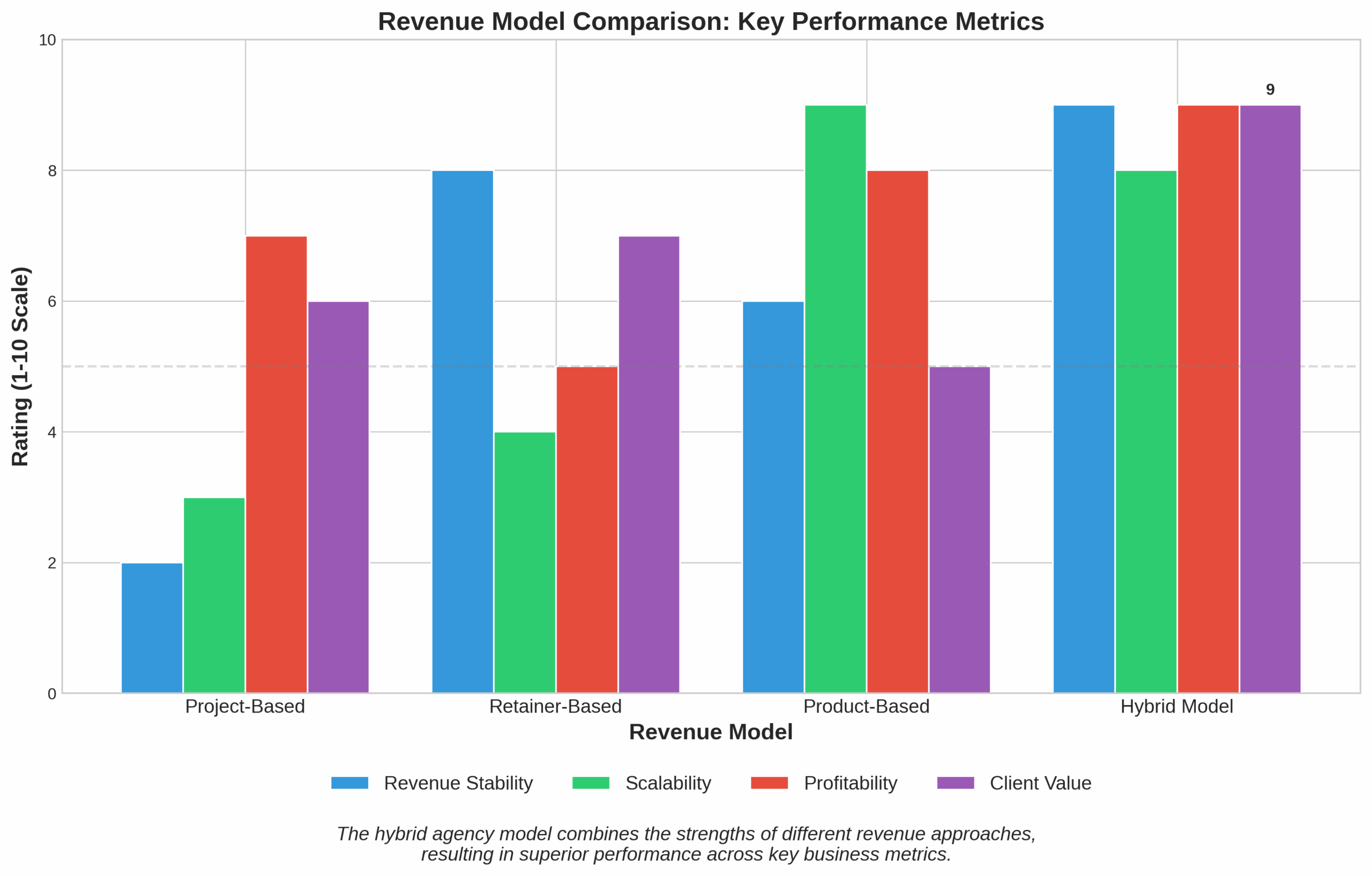
Step-by-Step Process for Productizing Services
Identifying Productization Opportunities Within Your Service Offerings
Conduct a Service Inventory Analysis
- Repeatability: How much of the service follows a consistent process that could be standardized?
- Client Demand: Is there sufficient market demand to justify productization?
- Expertise Leverage: Does the service allow you to leverage your agency’s unique expertise?
- Scalability Potential: Can the service be delivered without proportional increases in time and resources?
- Value Perception: Will clients perceive clear value in a productized version?
Look for Patterns in Client Requests
Analyze Profitability and Resource Allocation
Conduct Client Interviews
- “What recurring challenges does your business face in our area of expertise?”
- “Which of our services provide the most consistent value to your organization?”
- “What would make our services more accessible or valuable to you?”
Creating Standardized Processes and Methodologies
Document Current Best Practices
Develop Process Maps and Standard Operating Procedures
Create Templates and Frameworks
- Assessment frameworks
- Report templates
- Project plans
- Client questionnaires
- Deliverable formats
Implement Quality Control Mechanisms
Test and Refine
Packaging and Positioning Productized Services
Define Clear Service Tiers
- Basic Tier: Core deliverables with limited customization
- Standard Tier: Enhanced deliverables with moderate customization
- Premium Tier: Comprehensive deliverables with significant customization and additional support
Create Compelling Service Names and Descriptions
Develop Visual Representations
- Process infographics
- Comparison charts between service tiers
- Sample deliverables
- Results dashboards
Establish Clear Deliverables and Timelines
- Exactly what deliverables are included
- When each component will be delivered
- What the client needs to provide
- How results will be measured and reported
Highlight Differentiation from Custom Services
- Faster implementation
- Proven methodology
- Predictable outcomes
- Cost efficiency
Pricing Strategies for Productized Services
Value-Based Pricing Approach
- The problem’s urgency and importance to clients
- The typical ROI clients receive
- What alternatives (including doing nothing) would cost the client
- The unique value your methodology provides
Fixed Pricing with Clear Boundaries
Consider Subscription Models
- Monthly analytics reports
- Ongoing content creation
- Regular technical maintenance
- Performance monitoring
Volume Discounts and Bundles
Test Different Price Points

Implementation Roadmap for Transitioning Services to Products
Phase 1: Internal Preparation (1-2 Months)
- Finalize service documentation and processes
- Train team members on standardized delivery
- Develop marketing materials and sales tools
- Set up tracking systems for measuring results
Phase 2: Soft Launch (2-3 Months)
- Introduce productized offerings to select existing clients
- Gather feedback and refine processes
- Document case studies and results
- Train sales team on positioning and objection handling
Phase 3: Market Launch (3-6 Months)
- Formally launch productized services to your full market
- Implement marketing campaigns highlighting the new offerings
- Actively solicit client testimonials and case studies
- Monitor performance metrics and client satisfaction
Phase 4: Optimization (Ongoing)
- Regularly review delivery processes for efficiency improvements
- Update offerings based on market feedback and results
- Explore opportunities for additional productized services
- Consider technology investments to further streamline delivery
Case Studies of Successful Service Productization
Case Study 1: Digital Marketing Agency
- They reduced delivery time by 40%
- Increased profit margins from 30% to 45%
- Expanded their client base to include smaller businesses previously unable to afford custom services
- Created a clear upgrade path to more comprehensive services
Case Study 2: Web Development Firm
- Technical performance assessment
- UX evaluation and recommendations
- Content refresh
- SEO optimization
- Analytics implementation
This productized offering:
- Generated a new revenue stream from past clients
- Created a steady workflow during traditionally slower periods
- Established a pipeline for larger redesign projects
- Improved client retention by maintaining ongoing relationships
Case Study 3: Branding Consultancy
- Attracted startups and small businesses previously priced out of their services
- Created a feeder system for their full branding services
- Allowed junior team members to gain experience while senior staff focused on complex projects
- Generated predictable monthly revenue that stabilized cash flow
By thoughtfully productizing appropriate services, agencies can create more scalable, profitable offerings while maintaining the flexibility to provide custom solutions when appropriate. This balanced approach is a cornerstone of successful hybrid agency models, providing stability while creating opportunities for growth and innovation.
Pricing Strategies for Hybrid Model Components
Value-Based Pricing Approaches
Quantifying Value for Different Service Types
For Strategic Services:
- Estimate the financial impact of strategic recommendations
- Calculate the cost of inaction or status quo
- Assess risk reduction value
- Consider competitive advantage created
For Implementation Services:
- Measure efficiency gains compared to in-house implementation
- Calculate time-to-market acceleration value
- Assess quality improvement value
- Quantify resource reallocation benefits
For Productized Services:
- Determine cost savings compared to custom solutions
- Calculate time savings for the client
- Assess standardization and consistency benefits
- Quantify accessibility advantages
Communicating Value Effectively
- Documenting past client results with specific metrics
- Creating ROI calculators for different service offerings
- Presenting case studies that highlight value delivered
- Training team members to discuss value rather than deliverables or hours
Overcoming Value-Based Pricing Objections
- Offering pilot projects to demonstrate value before larger commitments
- Creating guarantee structures that reduce perceived risk
- Providing comparison scenarios showing cost vs. benefit
- Developing testimonials that specifically address value received relative to investment
Tiered Pricing Structures for Different Service/Product Combinations
Core-Plus-Options Model
- Core Package: Essential services that deliver fundamental value
- Enhancement Options: Additional services that augment the core offering
- Premium Additions: High-value components for clients with specific needs or larger budgets
This model works particularly well when combining retainer services with project-based work, allowing clients to maintain a core relationship while adding project components as needed.
Good-Better-Best Framework
- Good Tier: Entry-level offering with essential components
- Better Tier: Mid-level offering with enhanced features and support
- Best Tier: Premium offering with comprehensive services and priority attention
This framework is especially effective for productized services, creating clear differentiation while allowing clients to self-select based on their needs and budget.
Custom-Hybrid-Productized Continuum
- Custom Services: Highest price point, completely tailored to client needs
- Hybrid Services: Mid-range price point, combining standardized frameworks with customization
- Productized Services: Lower price point, fully standardized with minimal customization
This model allows you to serve different market segments while clearly communicating the value-price relationship across your service spectrum.
Subscription and Membership Models
Service Subscription Tiers
- Basic Subscription: Core services delivered on a regular cadence
- Standard Subscription: Enhanced service package with additional deliverables
- Premium Subscription: Comprehensive service package with priority and exclusivity
Effective service subscriptions typically include:
- Clear deliverable schedules
- Defined communication protocols
- Regular reporting and reviews
- Established update or refresh cycles
Membership and Retainer Hybrids
- Access Component: Provides ongoing access to expertise, resources, or proprietary tools
- Service Component: Includes a defined allocation of service hours or deliverables
- Community Component: Offers peer networking, exclusive content, or events
This approach works well for agencies with specialized expertise or methodologies, creating value beyond direct service delivery.
Product-Service Bundles
- Product Access: Subscription to proprietary tools, platforms, or content
- Implementation Support: Services to ensure effective product utilization
- Strategic Guidance: Advisory services that maximize product value
This model is particularly effective for agencies transitioning from pure services to more scalable product offerings.
Performance-Based Compensation Components
Results-Based Fee Structures
- Base-Plus-Performance: Combines a guaranteed base fee with performance bonuses
- Scaled Compensation: Fees that increase or decrease based on predefined metrics
- Shared Success: Revenue sharing or profit participation models
When implementing performance-based components, ensure:
- Metrics are clearly defined and measurable
- Baseline expectations are realistic
- External factors are accounted for
- Measurement methodologies are agreed upon in advance
Risk-Reward Balancing
- Higher risk components should offer proportionally higher rewards
- Risk should be distributed fairly between agency and client
- Performance elements should represent a meaningful but not dominant portion of compensation
- Caps and floors may be appropriate to limit extreme outcomes
Performance Integration Across Model Components
- Retainer Components: Quarterly performance reviews with fee adjustments
- Project Components: Milestone-based bonuses for exceeding targets
- Product Components: Usage-based pricing or outcome-driven licensing
Creating Pricing Packages That Combine Different Revenue Streams
Strategic Package Design
- Foundation Elements: Core services that establish the client relationship
- Enhancement Elements: Additional services or products that address specific needs
- Scalability Elements: Components that can flex with client growth or changing requirements
When designing packages, consider:
- Natural complementarity between components
- Client journey and evolving needs
- Resource allocation efficiency
- Profitability across the package lifecycle
Balancing Customization and Standardization
- Standardized Components: Creating efficiency and scalability
- Customizable Elements: Addressing unique client needs
- Flexible Frameworks: Allowing adaptation without complete customization
This balance allows you to maintain margins while still delivering tailored value.
Long-Term Value Creation
- Entry Packages: Lower-commitment offerings that demonstrate value
- Core Relationship Packages: Mid-level offerings that establish ongoing partnerships
- Strategic Partnership Packages: Comprehensive offerings for deep client integration
This progression creates natural upsell opportunities while delivering increasing value throughout the client lifecycle.
Communicating Value and Pricing to Clients
Value Narrative Development
- The transformation clients will experience
- The specific problems your offerings solve
- The unique approach that differentiates your agency
- The tangible and intangible benefits clients receive
Pricing Presentation Frameworks
- Contrast Frameworks: Comparing your solution to alternatives (including doing nothing)
- Investment Frameworks: Positioning fees as investments with expected returns
- Phased Frameworks: Breaking larger engagements into manageable investment stages
- Option Frameworks: Presenting multiple packages to facilitate decision-making
Handling Pricing Objections
- Value Reinforcement: Redirecting focus from price to value delivered
- Scope Adjustment: Offering to modify scope rather than simply reducing price
- Alternative Packages: Presenting different options that meet budget constraints
- Strategic Concessions: Knowing when and how to make pricing adjustments without undermining value
Case Studies: Successful Hybrid Pricing Models
Case Study 1: Digital Marketing Agency
- Core Retainer: Monthly strategic guidance and performance monitoring
- Project Components: Quarterly campaign development and creative refreshes
- Product Element: Access to proprietary analytics dashboard and content library
- Performance Component: Quarterly bonuses based on lead generation metrics
This approach increased average client value by 40% while improving retention rates from 70% to 85%.
Case Study 2: Branding and Design Firm
- Foundation Package: Brand strategy development and identity system
- Implementation Projects: Website, collateral, and environmental design
- Productized Brand Management: Standardized brand governance tools and training
- Retainer Component: Quarterly brand reviews and refinement
This model allowed them to increase initial project size while creating ongoing revenue streams that previously didn’t exist.
Case Study 3: Web Development Agency
- Project Component: Custom website development
- Product Component: Proprietary CMS with tiered licensing
- Subscription Element: Ongoing maintenance and security packages
- Upsell Structure: Quarterly enhancement projects
This approach transformed their feast-or-famine project cycle into predictable revenue while increasing client lifetime value by over 300%.
Client Transition Strategies for Existing Relationships
Assessing Current Client Portfolio for Hybrid Model Opportunities
Client Relationship Audit
- Relationship Strength: How strong is your partnership? Clients with high trust are better candidates for early transitions.
- Current Engagement Model: What is the existing arrangement, and how significantly would it change?
- Growth Potential: Which clients have unmet needs that could be addressed through expanded services?
- Strategic Alignment: Which clients align with your agency’s long-term vision and specialization areas?
- Profitability: Which relationships are currently most and least profitable? How might a hybrid approach affect this?
Opportunity Identification Matrix
- Retainer Expansion Opportunities: Clients who could benefit from more comprehensive ongoing services
- Project Addition Candidates: Retainer clients who have periodic needs that could be addressed through structured projects
- Productization Possibilities: Services currently delivered as custom work that could be standardized
- Upselling Potential: Specific additional services that would benefit each client
Client Segmentation for Phased Transition
- Early Adopters: Clients likely to embrace change and see immediate benefits
- Second Wave: Clients who may need more evidence before transitioning
- Custom Relationship: Clients who may need to maintain primarily custom arrangements
- Potential Exits: Relationships that may not fit your evolving model
This segmentation allows for a phased approach that minimizes risk while creating success stories to support broader transitions.
Communicating Changes to Existing Clients
Framing the Transition Positively
- Emphasize enhanced value delivery, not internal restructuring
- Focus on how changes will improve results, not just change processes
- Highlight new capabilities or offerings being added, not just modifications to existing services
- Frame the transition as evolution rather than disruption
Personalized Communication Approaches
- In-Person Presentations: For significant changes with key clients
- Video Conferences: For detailed discussions requiring visual aids
- Executive Summaries: For busy decision-makers who need concise information
- Phased Disclosure: For clients who may need time to process changes
Addressing Potential Concerns Proactively
- Service Continuity: How will ongoing work be maintained during transitions?
- Team Relationships: Will they still work with the same people?
- Pricing Implications: How will changes affect their investment?
- Contract Terms: What modifications to existing agreements might be needed?
Prepare thoughtful responses that demonstrate you’ve considered these aspects carefully.
Timing Considerations
- Align with natural contract renewal cycles when possible
- Avoid introducing changes during critical client projects or campaigns
- Consider client budget cycles and planning periods
- Allow sufficient lead time for clients to adjust their own planning
Upselling Additional Services to Current Clients
Identifying High-Value Upsell Opportunities
- Client Need Alignment: Services that address known pain points or goals
- Natural Extension: Services that logically build on current engagements
- Demonstrated Expertise: Areas where you can show proven results
- Profit Potential: Services with favorable margins and resource requirements
Strategic Service Additions
Hosting Services
- Managed Website Hosting: Providing reliable, secure hosting with proactive maintenance
- Application Hosting: Supporting custom applications or tools developed for clients
- Content Delivery Networks: Enhancing performance for global or high-traffic sites
- Backup and Recovery Systems: Ensuring business continuity and data protection
AI-Enhanced SEO
- AI-Powered Content Optimization: Using artificial intelligence to enhance content performance
- Predictive Keyword Analysis: Identifying emerging opportunities before competitors
- Automated Performance Monitoring: Providing real-time insights and adjustments
- Competitive Intelligence Systems: Tracking competitor movements and market changes
Data as a Service
- Custom Analytics Dashboards: Delivering actionable business intelligence
- Market Research Subscriptions: Providing ongoing industry and competitor insights
- Performance Benchmarking: Comparing client metrics against industry standards
- Predictive Trend Analysis: Identifying emerging opportunities and challenges
Packaging Upsells Effectively
- Bundled Offerings: Package complementary services at advantageous pricing
- Tiered Structures: Create good-better-best options that encourage upgrades
- Trial Periods: Offer limited-time access to demonstrate value
- Phased Implementation: Break larger additions into manageable stages
Value Demonstration Strategies
- Pilot Programs: Implement services on a limited basis to demonstrate results
- Case Studies: Share relevant success stories from similar clients
- Complimentary Assessments: Provide initial analysis that reveals opportunity areas
- ROI Projections: Create customized forecasts of expected returns
Piloting New Approaches with Receptive Clients
Pilot Program Design
- Clear Objectives: Define specific goals and success metrics
- Defined Timeframe: Establish a clear beginning and end for evaluation
- Enhanced Attention: Provide additional oversight and support during the pilot
- Feedback Mechanisms: Create structured ways to gather client input
- Documentation Process: Capture learnings, challenges, and successes
Selecting Ideal Pilot Participants
- Innovation-Minded: Clients who embrace new approaches
- Collaborative Relationship: Partners who provide constructive feedback
- Representative Challenges: Clients whose needs reflect your broader portfolio
- Reasonable Expectations: Partners who understand the nature of pilots
- Strategic Importance: Clients whose success stories will influence others
From Pilot to Broader Implementation
- Process Refinement: Adjust workflows based on pilot experiences
- Value Proposition Enhancement: Strengthen your messaging based on actual results
- Pricing Calibration: Fine-tune pricing based on delivered value and resource requirements
- Case Study Development: Create compelling narratives from successful pilots
- Expansion Planning: Develop a phased approach for broader implementation
Managing Resistance and Addressing Concerns
Common Resistance Patterns
- Status Quo Bias: Preference for familiar processes regardless of potential benefits
- Value Uncertainty: Concern about whether changes will deliver promised improvements
- Relationship Anxiety: Worry about disruption to trusted team connections
- Budget Constraints: Concerns about potential cost increases
- Implementation Burden: Resistance to the effort required to adapt to new approaches
Tailored Response Strategies
- For Status Quo Bias: Demonstrate concrete advantages while emphasizing continuity
- For Value Uncertainty: Implement phased approaches with clear success metrics
- For Relationship Anxiety: Maintain key personnel connections while introducing new capabilities
- For Budget Concerns: Focus on ROI and consider phased investment approaches
- For Implementation Concerns: Emphasize your role in managing transition complexity
When to Accommodate vs. When to Stand Firm
- Accommodate: When requests align with your strategic direction and can be profitably delivered
- Negotiate: When partial accommodation can meet core needs while maintaining model integrity
- Stand Firm: When requests fundamentally undermine your business model or profitability
The Client Selection Integrity Principle
- Evaluate Fit: Assess whether each client truly aligns with your evolving business model
- Consider Profitability: Analyze whether relationships will be sustainable under the new approach
- Assess Resource Impact: Determine whether accommodating certain clients will divert resources from better opportunities
- Maintain Standards: Remember that there is no shortage of clients who genuinely need and deserve your help
Case Study: Long-Term Client Relationship Since 2007
Relationship Evolution
Key Transition Points
- Initial Project (2007): $15,000 website development
- Maintenance Retainer (2008): $1,500/month for updates and support
- Digital Marketing Addition (2010): $3,500/month including SEO and content
- Brief Departure (2012): Client left for another agency
- Return and Expansion (2013): Returned with expanded $5,000/month engagement
- Hosting & Security Addition (2015): Added $1,500/month for managed hosting
- Data Intelligence Services (2018): Added $2,750/month for analytics and reporting
- Current Relationship (2023): $9,750/month ($117,000 annually) comprehensive program
Success Factors
- Continuous Value Demonstration: Regularly showing ROI and business impact
- Relationship Investment: Maintaining strong personal connections beyond deliverables
- Proactive Problem Solving: Addressing issues before they became significant concerns
- Strategic Additions: Introducing new services that complemented existing work
- Recovery Excellence: When the client briefly left, maintaining professionalism and demonstrating willingness to earn the business back
Lessons for Transition Management
- Patience Pays: Building a six-figure relationship took years of thoughtful evolution
- Recovery Is Possible: Even when clients leave, maintaining relationships can lead to future opportunities
- Value Trumps Price: By focusing on value creation rather than price competition, the relationship survived competitive pressures
- Continuous Evolution: The relationship has constantly evolved rather than remaining static
Transitioning existing clients to a hybrid agency model requires careful planning, clear communication, and strategic implementation. By thoughtfully assessing opportunities, communicating changes effectively, piloting new approaches, and addressing concerns proactively, agencies can transform their client relationships while minimizing disruption. The result is deeper, more valuable partnerships that benefit both the agency and its clients.
Resource Allocation Frameworks for Hybrid Operations
Team Structure Considerations for Hybrid Models
Core Team vs. Extended Network
Core Team Elements:
- Leadership and strategy roles
- Client relationship managers
- Project/product managers
- Specialized expertise critical to your positioning
- Quality assurance and standards maintenance
Extended Network Elements:
- Specialized technical skills needed intermittently
- Production and implementation resources
- Surge capacity for peak periods
- Geographic or market-specific expertise
- Emerging skill areas being tested
The Elastic Agency Approach
- Premium Pricing Structure: Charge higher rates for owner or senior team involvement
- Trusted Freelancer Network: Maintain relationships with reliable independent professionals
- Premium Freelancer Compensation: Pay above-market rates to ensure availability when needed
- Minimal Fixed Overhead: Keep core team lean to reduce ongoing personnel costs
- Dynamic Scaling: Expand and contract resources based on current project demands
Team Organization Models
- Small, cross-functional teams dedicated to specific clients or industries
- Each pod capable of delivering across retainer, project, and product offerings
- Pods share resources and knowledge while maintaining client focus
- Teams organized around specific capabilities or disciplines
- Resources allocated to client needs across different engagement types
- Strong project management to coordinate across capability teams
- Stable core team handling strategy, client relationships, and quality control
- Flexible resources engaged for specific implementation needs
- Clear workflows connecting core and flexible resources
- Dedicated product development and maintenance team
- Service delivery team that implements and customizes products
- Shared strategy and client management layer
Role Evolution Requirements
- T-Shaped Professionals: Team members with deep expertise in one area plus broader capabilities
- Client Strategists: Relationship managers who can identify opportunities across your hybrid offerings
- Resource Coordinators: Specialists in optimizing allocation across different engagement types
- Knowledge Connectors: Team members who ensure learning transfers between projects and products
Technology and Systems Requirements
Integrated Management Platforms
- Project and Retainer Management: Tools that handle both ongoing and discrete work
- Resource Allocation: Systems that optimize team utilization across engagement types
- Client Communication: Platforms that maintain consistent client experience regardless of engagement model
- Knowledge Management: Solutions that capture and share insights across the organization
Automation Opportunities
- Routine Deliverable Production: Templating and automation for standard outputs
- Client Reporting: Automated data collection and report generation
- Resource Forecasting: Predictive tools for capacity planning
- Quality Assurance: Automated checks for deliverable standards
Product Development Infrastructure
- Development Environments: Technical infrastructure for product creation and testing
- Deployment Systems: Tools for distributing and updating products
- User Management: Systems for handling product access and permissions
- Support Infrastructure: Platforms for managing product-related client needs
Data Integration Requirements
- Client History Integration: Comprehensive view of all client interactions and deliverables
- Financial Performance Tracking: Unified profitability analysis across revenue streams
- Resource Utilization Monitoring: Holistic view of how team members are deployed
- Cross-Selling Intelligence: Data that identifies opportunities to expand client relationships
Financial Planning and Cash Flow Management
Revenue Stream Balancing
- Stability Foundation: Maintain sufficient retainer revenue to cover core operating expenses
- Growth Drivers: Use project revenue to fund expansion and investment
- Profit Enhancers: Develop product revenue to improve overall margins
- Risk Distribution: Diversify across industries and client types to reduce vulnerability
Investment Prioritization Framework
- Return Timeline: Balance short-term returns with long-term potential
- Strategic Alignment: Prioritize investments that advance your positioning
- Risk Profile: Maintain a portfolio of safer and more speculative investments
- Resource Requirements: Consider both financial and team capacity implications
Cash Flow Optimization Strategies
- Retainer Structuring: Front-load retainer payments to improve cash position
- Project Milestone Planning: Design payment schedules to fund project execution
- Product Development Financing: Consider alternative funding for product creation
- Pricing Model Innovation: Implement annual prepayment discounts or other incentives
Profitability Analysis Approaches
- Contribution Analysis: Understand how each component contributes to overhead coverage
- Lifetime Value Calculation: Assess client relationships based on full engagement history
- Cross-Selling Impact: Measure how different services drive additional revenue
- Resource Efficiency Metrics: Evaluate profitability relative to resource consumption
Project Management Adaptations for Hybrid Delivery
Methodology Selection and Adaptation
- Agile Approaches: Often ideal for product development and iterative client work
- Waterfall Elements: May be appropriate for defined-scope project components
- Kanban Systems: Useful for ongoing retainer work with variable priorities
- Hybrid Methodologies: Customized approaches combining elements of multiple frameworks
Resource Sharing Protocols
- Capacity Allocation: How team capacity is distributed across retainers, projects, and products
- Priority Frameworks: How conflicts between different work types are resolved
- Transition Processes: How team members move between different engagement types
- Escalation Procedures: How resource conflicts are addressed when they arise
Client Involvement Calibration
- High-Touch Collaboration: Strategic projects and relationship development
- Structured Engagement: Standardized projects with defined client inputs
- Self-Service Elements: Product components with minimal agency intervention
- Automated Touchpoints: Systematic client communications and updates
Cross-Functional Coordination
- Strategy-Execution Alignment: Ensuring strategic direction informs all delivery
- Sales-Delivery Handoffs: Creating smooth transitions from sales to implementation
- Product-Service Integration: Connecting product and service components effectively
- Innovation Transfer: Moving insights between custom and productized work
Client Selection and Qualification Criteria
Ideal Client Profile Development
- Business Characteristics: Size, industry, growth stage, and market position
- Need Alignment: Challenges that match your specific capabilities
- Cultural Fit: Values and working style compatible with your approach
- Growth Potential: Opportunity to expand the relationship over time
- Budget Alignment: Financial capacity appropriate to your offerings
Red Flag Identification
- Financial Desperation: Clients investing “their last bit of money” who need immediate results
- Unrealistic Expectations: Demands that exceed what your services can reasonably deliver
- Excessive Haggling: Extreme focus on cost rather than value
- Respect Issues: Dismissive attitude toward your expertise or team
- Communication Problems: Inability to provide clear information or feedback
The 80/20 Rule Application
- Identify the 20% of clients likely to generate 80% of your revenue
- Recognize the 20% of clients that may consume 80% of your resources
- Focus business development on replicating your most profitable relationships
- Develop transition plans for clients that drain disproportionate resources
Qualification Process Design
- Discovery Framework: Systematic approach to understanding client needs
- Alignment Assessment: Evaluation of fit with your capabilities and model
- Value Potential Analysis: Estimation of potential value you can deliver
- Relationship Projection: Consideration of how the relationship might evolve
- Resource Impact Evaluation: Assessment of resource requirements
The “Need the Money” Trap
- Decision Review Process: Secondary evaluation of clients accepted despite red flags
- Opportunity Cost Analysis: Consideration of what resources could be doing instead
- Hidden Cost Calculation: Full accounting of the true cost of difficult clients
- Exit Strategy Planning: Clear criteria and process for ending problematic relationships
Measuring Success Across Different Revenue Streams
Holistic Performance Metrics
- Financial Health: Revenue, profitability, and cash flow across all streams
- Client Success: Outcomes and satisfaction across different engagement types
- Team Effectiveness: Utilization, efficiency, and satisfaction
- Business Development: Growth in existing accounts and new client acquisition
Revenue Stream-Specific Indicators
- Retention rate and average relationship duration
- Scope adherence and change request volume
- Upsell/cross-sell success rate
- Estimate accuracy and budget adherence
- Timeline performance and milestone achievement
- Repeat project rate from existing clients
- Adoption rate and active usage
- Support requirement levels
- Enhancement request patterns
Leading Indicator Development
- Client Engagement Patterns: Changes in communication frequency or tone
- Resource Allocation Trends: Shifts in how team capacity is distributed
- Pipeline Composition: Evolution of opportunity types and sizes
- Efficiency Trajectories: Trends in delivery time and resource requirements
Continuous Improvement Framework
- Regular Review Cadence: Scheduled evaluation of performance metrics
- Cross-Stream Learning: Mechanisms for sharing insights between different areas
- Experimentation Structure: Framework for testing potential improvements
- Feedback Integration: Systems for incorporating client and team input
Case Study: Integrated Resource Allocation in Action
Agency Background
Resource Allocation Challenges
- Team members accustomed to project work struggled with retainer mindset
- Resource conflicts arose between immediate project needs and long-term product development
- Client expectations varied widely across different engagement types
- Financial planning became more complex with multiple revenue streams
Framework Implementation
- 15 core team members focused on strategy, client management, and quality control
- 10 flexible roles that shifted between retainers and projects as needed
- Network of 30+ specialized freelancers engaged based on specific requirements
- Product development handled by a dedicated 4-person team
- 50% of core capacity reserved for retainer clients
- 30% allocated to projects with flexibility based on demand
- 20% dedicated to product development and improvement
- Freelance network providing surge capacity for projects
- Retainer revenue covering all fixed operating costs
- Project profit funding product development
- Product revenue improving overall margins
- Quarterly rebalancing of resource allocation based on performance
- Clear criteria for ideal clients across different engagement types
- Structured qualification process with multiple stakeholder input
- Regular portfolio review to identify expansion or transition opportunities
- Deliberate phase-out of clients misaligned with the evolved model
Results Achieved
- Overall revenue increased by 32%
- Profit margins improved from 18% to 27%
- Team satisfaction scores rose by 24%
- Client retention increased from 71% to 86%
- Product revenue grew to represent 15% of total revenue
Conclusion
Key Benefits of Hybrid Agency Models
Future Outlook for Agency Business Models
Implementation Recommendations
- Evaluate your current business model strengths and weaknesses
- Identify natural productization opportunities within your service offerings
- Assess your client portfolio for transition potential
- Review team capabilities and structure relative to hybrid requirements
- Define your specific hybrid model components and their integration
- Create pricing frameworks for different engagement types
- Develop resource allocation plans and team structure adjustments
- Establish success metrics and performance benchmarks
- Select 2-3 receptive clients for initial hybrid approach testing
- Develop and test productized service prototypes
- Implement modified team structures and workflows
- Gather feedback and refine your approach
- Gradually transition additional clients to appropriate hybrid components
- Formalize productized offerings and go-to-market strategies
- Implement supporting systems and technologies
- Adjust team structure and recruitment to support the evolved model
- Continuously monitor performance across different revenue streams
- Refine pricing and packaging based on market response
- Evolve resource allocation to maximize efficiency
- Identify new opportunities for model enhancement
